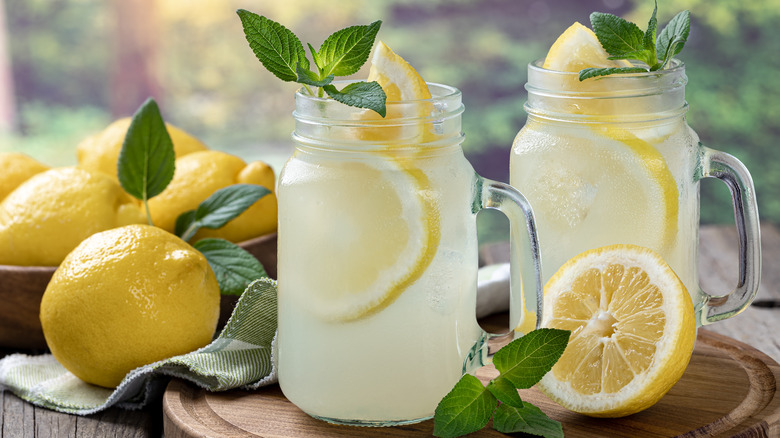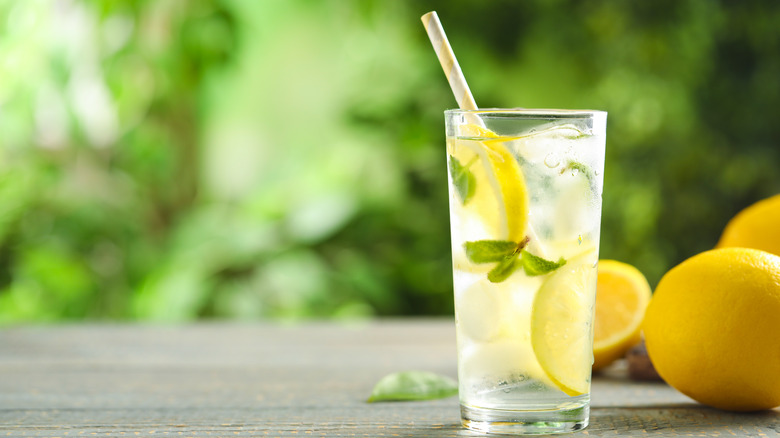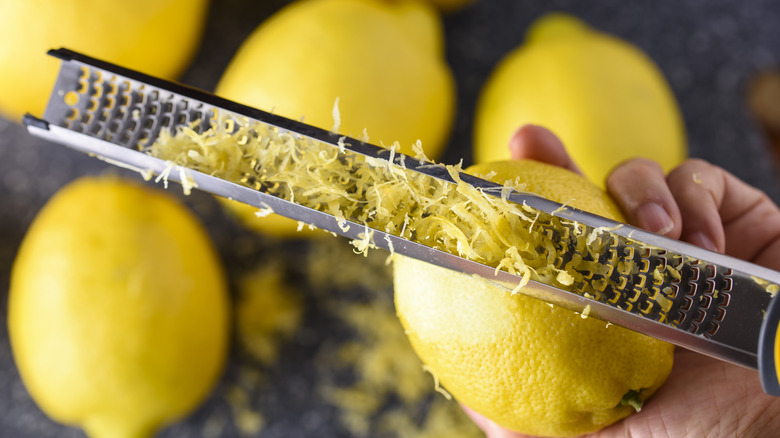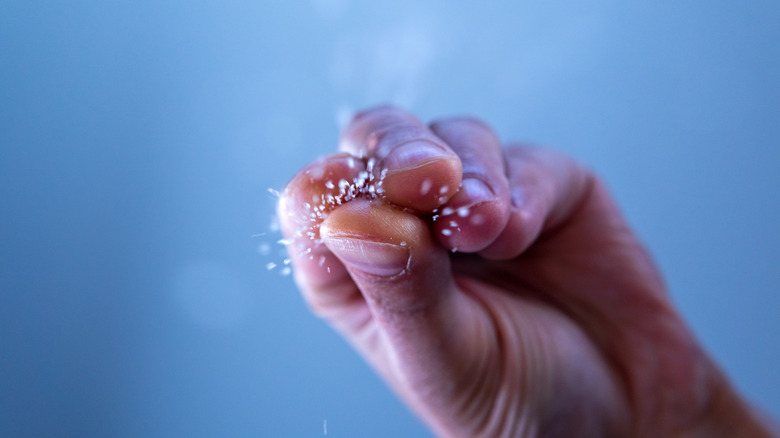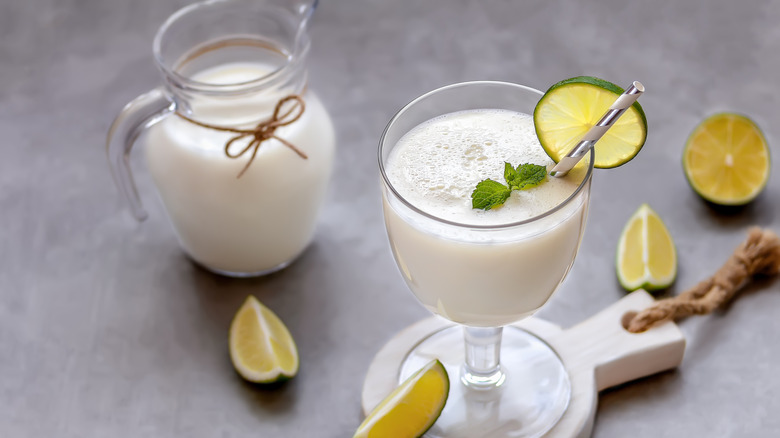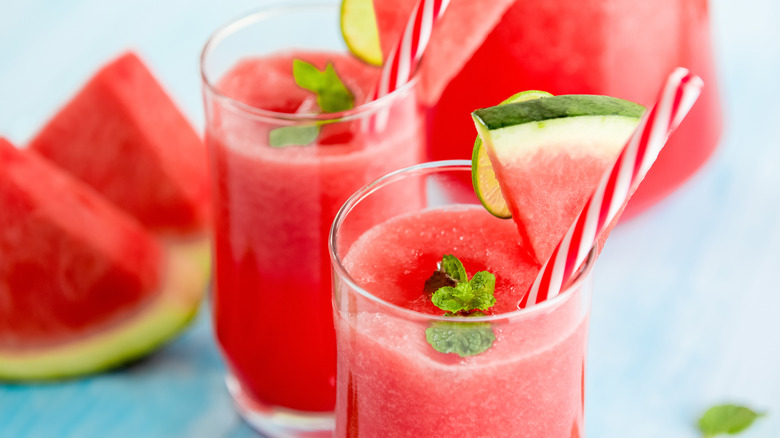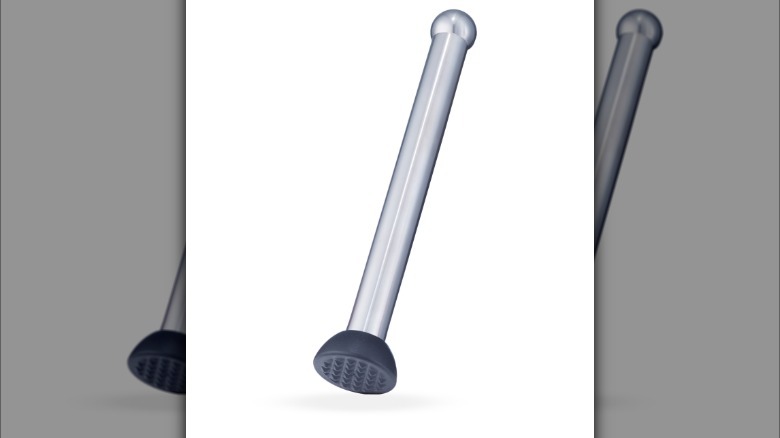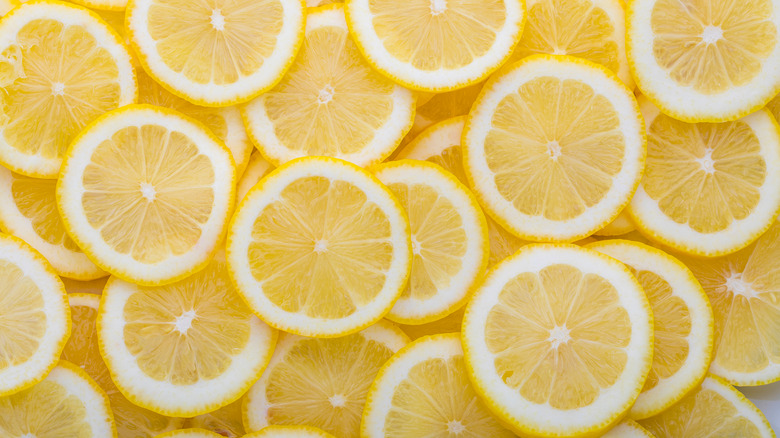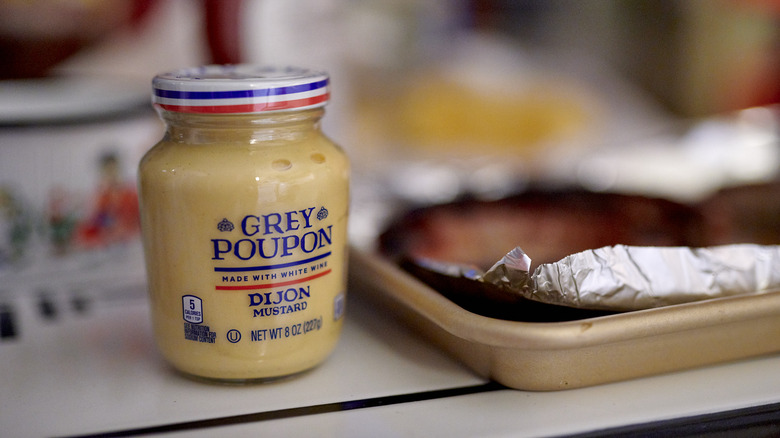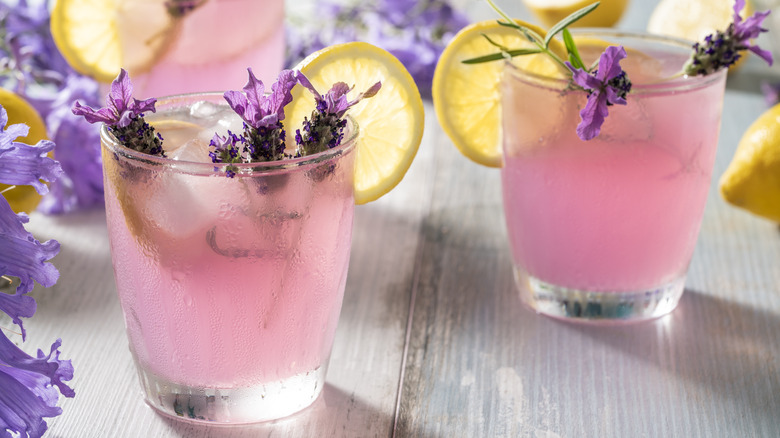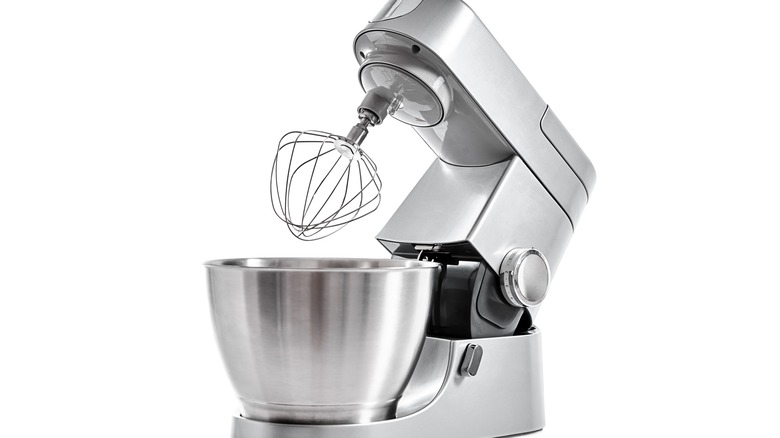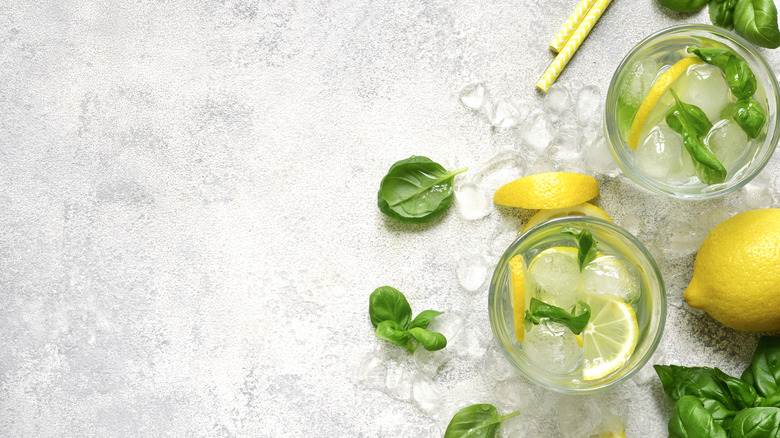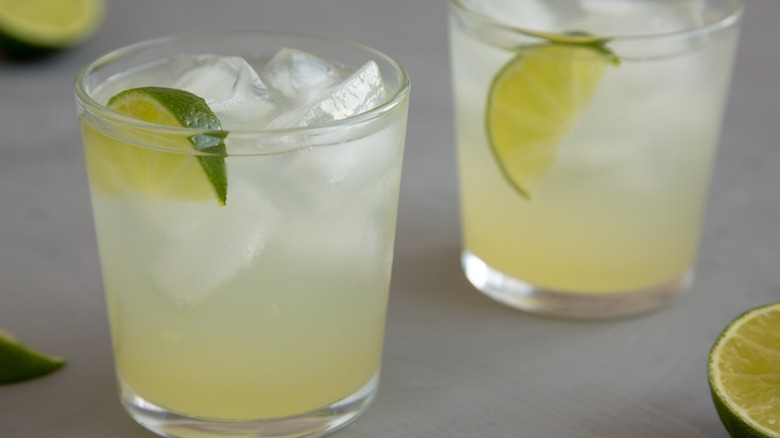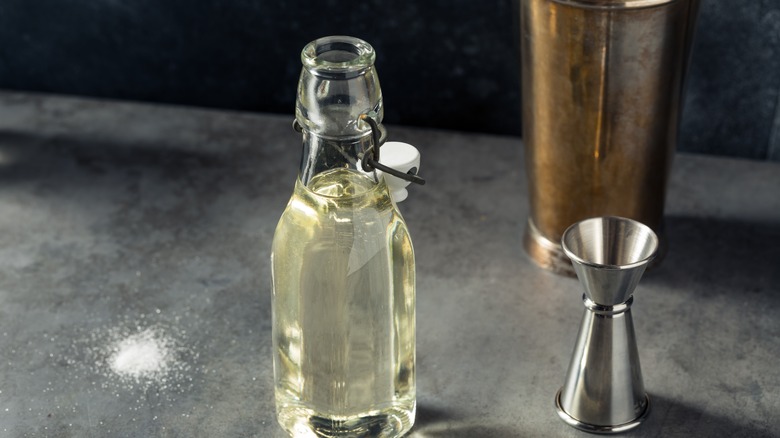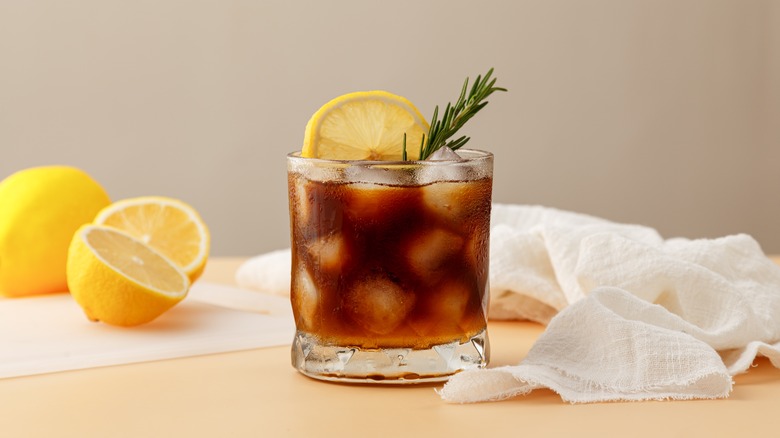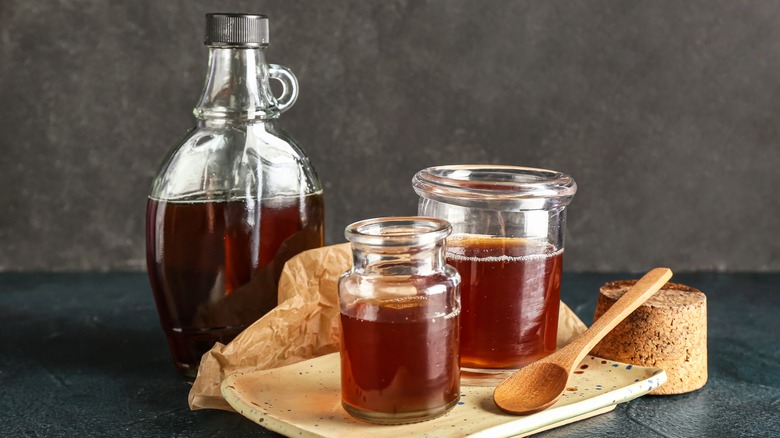16 Tips You Need To Make The Most Refreshing Summer Lemonade
There isn't a summer drink quite like lemonade. Its standard recipe — lemon juice, water, and sugar — hasn't changed much in the last thousand or so years. In fact, the earliest record for lemons was nearly 8 million years ago in China's Yunnan province. However, it's the medieval Egyptians that made the first precursors to the lemonade beverage that we know and love today. This society made kashkab, a drink made from citron leaves, a rinded fragrant citrus plant, and fermented barley, rue, and black pepper. After global trade expanded in the 17th and 18th centuries, lemons and sugar became more widely available across the globe — and the modern lemonade recipe was born.
People of all ages enjoy lemonade, especially on a hot summer day at the beach or a barbecue. Here are some of the many creative ways to dress up your standard lemonade recipe to make it more refreshing, flavorful, and worth the squeeze.
Add a hint of mint
When you think of an herb to pair with lemonade, your first thought is likely mint. It's the one, simple ingredient that will change your lemonade forever. The reason why mint is a popular addition to tangy lemonade is that it has a sweet undertone with herbal notes. Mint also has cooling qualities that make it a frequent addition to a range of summery beverages, including mint juleps and mojitos. If you have a small indoor plant, you can add a couple of leaves directly to your beverage or julienne them into your glass.
The Lebanese preparation of mint lemonade, limonana mint, uses an ounce of herbs per cup of lemon juice. Since the beverage is very mint-heavy, it is recommended that the mint be blended with a bit of lemon juice to make a purée. The more the mint is blended down, the more flavor will come through.
Grate in some lemon zest
If you want a more flavorful lemonade, reach for your microplane zester. You shouldn't forget the zest for homemade lemonade because the outer layer of the lemon contains high concentrations of essential oils that will elevate the lemon flavor of your beverage.
The best way to infuse the lemon zest into your lemonade isn't by zesting it right over the rim of the glass. Instead, use your fingers to mix together the lemon zest and the granulated sugar before adding it to the mixture. You'll need to rub the two together for about two to three minutes or until you start to smell the delicious lemon aroma coming from your fingers. When you're zesting your lemon, it's important only to zest the outside yellow layer. If you zest too aggressively, you risk getting into the white pith, which is much more bitter and can ruin the taste of your beverage.
Add a pinch of salt to elevate other flavors
Salt often makes an appearance in cookie recipes and other sweet applications because the saltiness balances out the other flavors in the batter. The same can be said if you add a pinch of salt to your lemonade. You'll find that a tiny bit of salt helps round out the sweetness of the sugar and reduces any bitter aftertaste caused by pesky pith pieces.
Science supports the idea that adding a pinch of salt to anything sweet helps boost the flavor. Gizmodo reports the sugar receptors in your mouth transfer glucose (sugar) onto the sweet-taste cells when sodium is present. This sensor tells our bodies that we're eating something sweet and further magnifies the taste.
If you're adding salt to your lemonade, it's essential only to add a pinch to not accidentally make your sweet lemonade turn savory. Standard table salt will work just fine for this hack.
Make lemonade creamy with dairy products
Whipped beverages have taken over the internet in recent years, including the infamous Dalgona coffee. But we would argue that making lemonade into a fancy, whipped beverage deserving of TikTok reposts is much more advantageous.
To make whipped lemonade at home, start by adding your lemon juice, heavy cream, and condensed milk into a blender with ice. Since the condensed milk is already sweetened, you won't need to add additional sugar to the blender. Pulse on high speed for about 15 seconds or until there are no chunks of ice left (you wouldn't want a pesky piece to get stuck in your straw). The consistency of this frozen beverage is just like a lemonade milkshake — and it's guaranteed to cool you off on a summer day. We recommend serving your whipped lemonade with a hefty serving of whipped cream and a garnish of citrus slices.
Integrate other summer fruits
Lemonade is the perfect blank canvas for other fruits and flavors. Watermelon lemonade is one of our favorite recipes because the addition of a melon adds both a mild undercurrent of flavor and the hydrating benefits of summer's favorite fruit. To make this drink at home, add lemon juice, simple syrup, and cubed watermelon to a high-speed blender. Keep blending until the purée comes out smooth and transfers over ice.
Strawberries are another fruit that adds a subtle element of flavor to your lemonade. You can make a homemade strawberry lemonade concentrate by cooking down lemon juice, zest, sugar, and cubed strawberries over medium heat for about 20 minutes. Once the concentrate is finished cooking, press the strawberries to extract as much of the flavor as possible before straining and cooling. Once you're ready to make your strawberry lemonade, mix one cup of concentrate with three cups of water. You'll have plenty of strawberry lemonade ready to go for your next barbecue or just for sipping on the front porch.
Muddle the fruit instead
The best tool for making a refreshing summer lemonade can be found with your mixologist tools. A muddler is a surprising kitchen tool that can help you make tastier lemonade. Muddling extracts flavors and aromas from the fruit that would otherwise be lost by squeezing out the juice.
If you don't have a muddler in your bar kit, you can use an old-fashioned potato masher instead. Use either of these tools to press the whole piece of lemon into a bowl or container; it will extract both the juice and the oils from the rind. The most effective technique for muddlingis to place the lemon in a small mason jar, cut side down, and use a gentle method to press and push the juice out of the lemon. Once you have muddled your lemon juice, strain out the whole pieces of lemon and any seeds that may have popped out.
Roast the lemons in the oven to curb their tartness
Roasted lemons are the perfect accompaniment for roasted asparagus or salmon, but you've probably never thought about roasting your lemons before making lemonade. Roast lemons make for perfectly sweet lemonade because the roasting process will caramelize the sugars. The heightened sugar will curb the acidity and bitterness of the beverage while also cutting down on your need for added sugars to sweeten your drink.
There are many different methods you can employ to roast your citrus. The first is in your oven: Place a single sheet of the halved citrus, the cut side down on a baking sheet, and cook at 400 degrees Fahrenheit until the edges are slightly browned. Then, you can juice (or muddle for even more flavor) into a sieve to remove any leftover pulp. You can also brush the lemon's cut side with olive oil and grill until the cut side is charred. Avoid moving your fruit around on the grill to ensure that each half gets the most concentrated flame possible.
Make it spicy with an unexpected condiment
We admit this one is a little out there. The unexpected ingredient that makes it easy to whip up spiced lemonade is the same one you use for spicy deviled eggs or potato salad. That's right — it's Dijon mustard. Add a teaspoon of this classic condiment to a half-cup of lemonade for a savory, spicy kick. Dijon mustard is the only type that will suffice — save the French's yellow for your hot dogs.
Dijon mustard is packed full of flavor because it's made with black and brown mustard seeds. Plain, yellow mustard utilizes the more subdued yellow and white mustard seeds, which won't impart the same punch. Dijon mustard lemonade pairs well with a whole host of garnishes and other additions like cucumber, orange, and mint. If you add this viscous condiment, be sure to mix your beverage well or else you could end up with a mustard clog in your straw.
Get boozy
The easiest way to make anything better is to add booze. And luckily, a refreshing glass of lemonade and a shot of your favorite liquor go well together. Some of the best drinks to mix with lemonade include whiskey, vodka, and gin.
Whiskey is a go-to because the tangy lemon complements the oaky, caramel flavor of the alcohol. Feeling a cocktail rather than just a shot? Try making a classic frothy whiskey sour with simple syrup, lemon juice, egg whites, and whiskey, bourbon, or rye. If you're going the vodka route, we recommend mixing a clean-tasting, premium vodka brand like Ketel One or Belvedere with your simple sugar-sweetened lemonade. Besides the classics, add another flavor dimension with elderflower-infused vodka.
Finding a spirit compatible with your other ingredients is essential. For example, a floral gin pairs well with mint or herb-infused lemonade, while bourbon is a better option for an alcoholic Arnold Palmer.
Juice your lemons with a stand mixer
Hand cramps from juicing lemons are the worst. One appliance in your kitchen that makes making lemonade so much easier is a stand mixer. The stand mixer uses the same mechanics as a muddler or a potato masher; pressing the entire citrus pulls out more flavor and oils from the fruit, thus resulting in a more intense lemonade flavor. But the one difference is that your stand mixer offers you an easy, hands-off way to juice your lemons.
Start by quartering your lemons and placing them into a stand mixer outfitted with a paddle attachment. Beat the lemons on low speed for at least two minutes before straining out the whole pieces of lemon and seeds. This simple kitchen hack doesn't just work for lemonade but also for margaritas. You're only a few minutes away from having plentiful amounts of citrus juice, perfect for big-batch cocktails or a lemonade stand.
Make it fizzy with soda or seltzer
There's nothing quite like cracking open a cold seltzer on a hot summer day. If you want to elevate your seltzer-drinking experience, you can add a splash of lemonade concentrate to your glass. It's fun, bubbly, and will help keep you hydrated all summer long. You can also mix the lemonade directly with your favorite seltzer flavor to dilute the sweetness and the tanginess of the citrus beverage. Potential options include a compatible lemon or lime flavor or a more adventurous essence like grapefruit or raspberry.
Soda can be a star in your lemonade, too. Kentucky lemonade is made with bourbon, ginger ale, and lemonade, but you can also customize the recipe to omit the alcohol. The sharpness of the ginger plays well into the zestiness of the lemon juice. Or, try mixing your lemonade with a lemon-lime soda for a more neutral flavor.
Chop up some fresh basil
Mint isn't the only herb that has a rightful place with lemonade. Celebrity chef and food television personality Andrew Zimmern's perfect lemonade is made with simple syrup-sweetened lemonade and a judicious handful of basil and mint; it's the perfect accompaniment to his savory ballpark chicken wings. In a video posted to his YouTube channel, Zimmern explains that he makes a frozen version of his favorite drink using an equal amount of basil and mint cut straight from the plant. "The combination of basil and lemon and mint is extraordinary," he claims. He also notes that getting a "completely homogenized" blend of herbs, lemon juice, and syrup is important to prevent people from getting pieces of herbs stuck between their teeth.
Besides blending the basil into the lemonade, you can also muddle the leaves with sugar and lemon zest to help accentuate the natural oils in the herb.
Don't just stick to lemons
Don't restrict yourself to the confines of just lemons when making lemonade. There are other types of citrus that can add the same tanginess to the beverage and also novel flavors. One of the most obvious examples is lime juice. This citrus pairs well with brown sugar instead of white sugar, like in a Jamaican lemonade. Use equal parts lemon and lime juice in your recipe to prevent one from overpowering the other — citrus isn't particularly strong, after all.
Another fruit that can add a sweet, fruity flavor and beautiful pink hue to your lemonade is grapefruit. Ruby-red and star-ruby grapefruit produce the most vibrant colors, and when paired with the sweetness of honey, the brightness of this beverage is unmatched. To maximize the grapefruit's flavor, add a couple of slices into the pitcher with a splash of water and allow it to sit for a few hours and infuse.
Make a simple syrup rather than adding sugar
If you've ever sipped lemonade in the summer, you probably know the frustrating (yet, somewhat satisfying) feeling of shoving your straw all the way down to the bottom of the lemonade and sucking up pure, crunchy sugar. If you add granulated sugar to a cold beverage like lemonade, the two won't mix together well — thus leaving you with some stratification.
The tip to make sure all the sugar dissolves in your lemonade is to use a simple syrup mixture instead of straight sugar. Simple syrup is made by heating a 2-to-1 ratio of sugar to water over medium-high heat until the mixture is homogenous. Scientifically speaking, the hot water's faster molecular movement can more easily mix with the sugar molecules to create a solution that isn't gritty. Simple syrups don't have to be made with just sugar and water, either. You can infuse a range of summer fruits and herbs, including strawberries, elderflower, and even rhubarb.
Add coffee for a caffeinated kick
Coffee ... and lemonade? Although the pairing might be unconventional, it satisfies our caffeine itch. Cold brew is the most idyllic component in coffee lemonade because it doesn't have a particularly bitter or acidic taste like a standard iced coffee would. Since the flavor of the coffee is more intense than the lemons, a typical ratio for the beverage is one cup of double-strength (made with double the grounds) coffee to each half-cup of lemonade. To help mellow out the acidity, you can add a splash of soda water or seltzer.
If you're adding coffee to lemonade, try to use a coffee blend that complements the citrusy notes of the lemons. Dark roasts tend to produce a burnt flavor when mixed with lemonade, so a lighter or medium roast should be your go-to for this concoction. When you're ready to serve your beverage, layer the lemonade and the coffee and garnish with thinly-sliced lemon.
Use maple syrup
If you've visited northern New England on a hot summer day, you've probably seen roadside stands and restaurants selling maple lemonade. It's one of the best ways to use maple syrup because its sweetness and oaky undertones curb the astringent flavor of the lemon juice. The best kind of syrup to use for maple lemonade is medium or dark amber because these syrups tend to have a more pronounced maple flavor than other lighter varieties.
When working with maple syrup, it's crucial to account for the difference in sweetness between granulated sugar and maple syrup. Maple syrup is close to three times sweeter than standard sugar, which means that you won't need as much of it in your lemonade. As with any recipe, always taste-test as you go since adding more sweetener is much easier than balancing out a sickeningly sweet lemonade. Start with a couple of tablespoons of syrup and work your way up from there.
